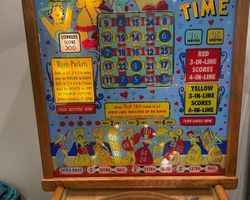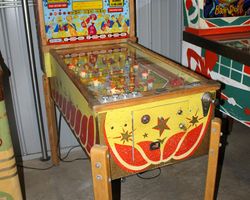Gay Time

Average Price: USD $300
Produced: 0
Machine Type: Electro-mechanical
Players: 1
Design by: Don Hooker
The pinball machine "Gay Time," released by Bally Manufacturing Corporation in May 1955, stands as a notable example of the electro-mechanical (EM) bingo machine genre. Unlike traditional flipper pinball games, bingo machines offered a different form of engagement, focusing on strategic ball placement and number matching rather than player-controlled flipper action. Bally, a prominent manufacturer during the mid-20th century, was particularly adept at developing these complex, odds-based games, and "Gay Time" encapsulates much of their innovative approach.
The design of "Gay Time" was primarily attributed to Don Hooker, an individual who also contributed to the patent for the machine's signature ball transfer mechanism. This patent, filed in March 1956 and granted in June 1956, covered the "BALL TRANSFER AND SWITCH MEANS," a core component of "Gay Time's" distinct gameplay. As Model Number 568, "Gay Time" represented an evolution in Bally's bingo line, refining concepts seen in earlier titles like "Gayety" (also from 1955), which featured similar "Magic-Pockets" but lacked "Gay Time's" advanced upper ball return hole for expedited play. The production run of these EM machines often spanned several months, and "Gay Time" found its place in arcades and amusement venues, contributing to the diverse landscape of coin-operated entertainment of its era. The machine's cabinet style, reflective of its bingo mechanics, was a robust wooden structure, commonly known as a "woodrail" design.
Signature Features and Design
"Gay Time" distinguishes itself with several key features that elevate its gameplay beyond simpler bingo machines. The most significant of these are the "Magic-Pockets," a series of seven player-controlled kick-out holes (numbered 1 to 7) located along the top row of the playfield. While all seven holes possess kick-out capabilities, holes 2 through 6 specifically function as two-way kick-out holes during gameplay, allowing players to strategically transfer a ball either left or right within that top row. This dynamic capability enables players to "jump the ball" across the top, providing a level of control and strategic depth uncommon in many bingo machines. Hole 7, while having two-way capability, primarily serves a practical function at the start of the game: it kicks balls to the right, efficiently clearing the row and guiding them into a nearby ball return hole, preventing slow drains and allowing play to commence more quickly.
Beyond the innovative "Magic-Pockets," "Gay Time" features 25 trap holes and 7 kick-out holes integrated into its playfield, all contributing to the machine's complex scoring matrix. The game operates on a "One Card" system, focusing on players completing lines on a virtual bingo card represented by the numbered holes. The inclusion of "4 Magic-Lines" further enhances the potential for strategic play and varied scoring outcomes. Aesthetically, "Gay Time" embodies the vibrant, illustrative style prevalent in 1950s pinball artwork. The backglass and playfield art feature cheerful coloring and designs typical of the era, drawing players into its appealing visual presentation. This visual appeal, combined with the machine's mechanical ingenuity, contributes to its overall charm and identity.
Playfield and Mechanics
The playfield layout of "Gay Time" is central to its bingo machine identity, designed for strategic ball placement rather than kinetic flipper action. The primary interactive area consists of the numbered holes, mimicking a bingo card grid. The top row, housing the "Magic-Pockets" (holes 1-7), is particularly crucial. After launching a ball, players observe its trajectory, hoping it lands in a desired hole. Should it land in a "Magic-Pocket" from 2 to 6, the player gains the unique ability to activate the kick-out mechanism, shifting the ball left or right along that upper row. This design philosophy emphasizes anticipation and a different form of skill – not precise flipper timing, but an understanding of odds and the strategic manipulation of the ball's final resting place.
The playfield artwork is an integral part of "Gay Time's" allure. The vibrant color palette and distinctive graphic elements of the 1950s are evident, with clear numbering and indicators for scoring zones, bonuses, and special features. Illumination is provided by incandescent bulbs, which light up corresponding numbers on the backglass or playfield as balls land in holes, signaling completed lines or achieved objectives. The overall aesthetic is clean and functional, guiding the player's eye to the crucial numbered targets and the paths for potential ball movement. The physical construction, typical of Bally's EM machines from the period, ensures robust operation, with the mechanical reels for score display clearly visible in the headbox, displaying the progress of the game.
Gameplay Dynamics
The core gameplay of "Gay Time" revolves around the player's ability to manipulate the odds and complete specific number combinations to achieve high scores and special awards. A game begins with a manual plunger launch, directing a ball onto the playfield, where it eventually comes to rest in one of the numbered holes. The objective is to form lines (vertical, horizontal, or diagonal) on a virtual bingo card, represented by the lit numbers on the backglass or playfield. "Gay Time" differentiates itself with its advanced scoring system, which includes "Red" and "Yellow" scoring matrices, offering various multipliers and awards based on the patterns formed.
Beyond basic line completions, the machine incorporates "corner bonuses" and two distinct "extra odds" scoring options, allowing for significant score accumulation if specific combinations of numbers are achieved. Crucially, the game also offers the potential for three "extra balls," which can prolong gameplay and provide more opportunities to hit desired numbers. The strategic depth truly emerges through the use of the "Magic-Pockets." Players must decide when and how to utilize these controlled kick-out holes to shift balls, aiming to complete a line, secure a bonus, or set up a future play. This "ball jumping" mechanic adds a layer of tactical decision-making, allowing a seemingly poor game to suddenly "turn into a great game" through clever manipulation. The interplay between luck (where the ball initially lands) and strategy (how the "Magic-Pockets" are used) defines the gameplay, offering a compelling experience for players who enjoy games of chance with a significant element of player influence.
Reception and Legacy
"Gay Time" holds a respected position within the specialized segment of bingo pinball enthusiasts. Its strengths are frequently highlighted, particularly its unique gameplay mechanics. The ability for players to "jump the ball" using the "Magic-Pockets" is consistently praised as an engaging and innovative feature that sets it apart. Collectors and players often note the abundance of scoring opportunities, including the Red and Yellow scoring, corner bonuses, and multiple extra odds options, all contributing to a rich and varied game experience that differentiates it from many other early 1950s woodrail bingos. The potential for "comebacks" through strategic play resonates strongly with players, providing a rewarding feeling of overcoming initial setbacks.
Bally's engineering staff is often commended for their thoughtful design in "Gay Time," having anticipated player desires for more control and depth in a bingo format. When compared to similar machines of its era, particularly Bally's own "Gayety," "Gay Time" is often preferred due to its more extensive feature set, with some enthusiasts even choosing to acquire "Gay Time" over its predecessor. Beyond its mechanical attributes, the machine's "great looks," specifically its coloring and artwork, are frequently cited as contributing to its overall appeal. The consensus within the community is that "Gay Time" is a "fantastic player." While minor mechanical issues are sometimes encountered with vintage machines, these are typically resolved through maintenance, reflecting more on the age of the machine than a design flaw. "Gay Time" endures as a testament to Bally's ingenuity in the EM era, a machine that refined the bingo pinball experience and remains a sought-after collectible for those who appreciate the unique blend of chance and player agency it offers. Its influence lies in its successful implementation of advanced player controls within the bingo framework, showcasing how the genre evolved beyond simple drops into a more interactive and strategic experience.
Sponsored Links
 Ebay Listings
Ebay Listings
 Auction Results
Auction Results
| Cost | Location | Date |
|---|---|---|
| USD $300 |  California, United States California, United States |
27 August, 2023 |
| USD $350 |  New York, United States New York, United States |
25 September, 2022 |
| USD $285 |  Virginia, United States Virginia, United States |
23 January, 2021 |
| USD $346 |  California, United States California, United States |
13 July, 2013 |
| GBP £512 |  Southend-on-sea, United Kingdom Southend-on-sea, United Kingdom |
08 September, 2011 |
| USD $305 |  California, United States California, United States |
01 June, 2008 |
| USD $175 |  United States United States |
16 April, 1999 |


Private Policy · Search Website · Contact Us
As an eBay Partner, we may earn a commission from qualifying purchases made through links on this site, at no additional cost to you.
All trademarks and copyrighted materials remain property of their respective owners. All other content copyright 2007 - 2025 Pinpedia.


